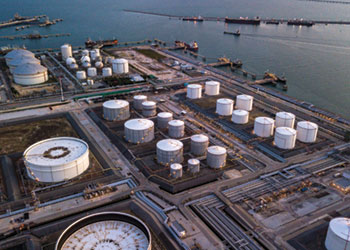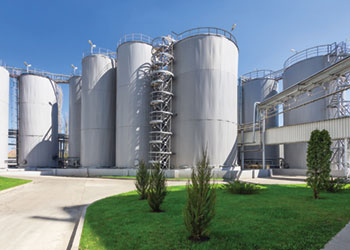

Despite challenged by renewables, the Middle East will see increased fossil fuels production, which in turn will push growth and innovation in the oil and gas storage terminals segment
The Middle East oil and gas storage terminal market is forecast to increase from $3.27 billion in 2022 to $5.51 billion in 2029 at a compound annual growth rate of 7.7 per cent, backed by strong demand for fossil fuel although this is challenge by the rise of renewable energy.
The storage segment still reels from the impacts of the Covid-19 pandemic, according to Fortune Business Insights in its report on the Middle East oil & gas storage terminal market.
The measures taken to curb the spread of Covid-19 measures, such as social distancing and travel bans, had challenged working conditions for many of the sector’s key processes
The price of oil then was dropping and the demand for refined products and chemicals was slowed due to travel restrictions, lockdowns and industrial slowdown.
According to the US Energy Information Administration (EIA), the Middle East petroleum and liquid fuel consumption averaged 94.4 billion barrels per day (bpd) in 2020, a decline of 5.6 billion bpd from the same period in 2019.
DRIVERS OF GROWTH & CHALLENGES
Storage terminals are crucial components of the world’s oil and gas production network and the centre of international trading in oil and gas. Countries rely on them to store oil and gas for commercial and strategic reserve purposes.
Oil terminals are situated around refineries or close to coast where ships can load and unload cargo. They are occasionally located close to urban areas where road tankers deliver goods to petrol stations and other direct consumers.
To supply and receive the product, certain terminals are connected via pipelines; rail, barges, and road tankers can all be used to access terminals.
Many nations have made increasing their storage space a top priority in order to meet oil import demand in the event of an import crisis or shortage due to the necessity for strategic petroleum reserves.
For instance, the European Union (EU) mandates that each member state maintain a strategic oil reserve sufficient to cover 90 days of annual domestic use.
Following the Covid-19 pandemic’s effects, several nations have planned to invest in order to increase the oil storage capacity in order to address any fuel or oil shortage resulting from an emergency and decrease reliance on fuel imports.
Additionally, during the forecast period, an increase in international oil commerce is anticipated.
In the upcoming years, the government will need to boost its investment in storage terminals due to a rise in oil demand from currently import-dependent nations.
The increase in demand for various fuels and storage tanks has elevated the need for the construction of oil terminals.
The market for oil storage terminals is driven by the increase in global demand for various petroleum products, resulting in increased utilisation of refineries and demand for the establishment of storage terminals.
Additionally, the demand for crude oil by-products such as diesel, LNG, aviation fuel, and gasoline has grown exponentially with a global increase in personal travel and air travel. Additionally, the industries that use crude oil products have seen an increase in consumption.
Furthermore, the demand for energy owing to rising population and rapid urbanisation is driving countries’ construction of oil storage terminals to suffice the country’s demand for oil or generate revenue by commercial use of the same.
MIDDLE EAST MARKET
In recent years, the number of storage terminals in the Middle East has grown due to its huge production capacity of fossil fuel.
The Middle East produces 31 per cent of the world’s oil, 18 per cent gas, and holds 48 per cent and 40 per cent of the world’s proven oil and gas reserves, respectively.
Additionally, rising power generation demand will fuel an increase in the use of fossil fuels. By 2050, the Middle East’s demand for power is expected to triple, and will electricity will account for 70 per cent of all energy used in buildings, replacing natural gas in homes.
This will boost the demand for more storage.
However, what could limit the need for oil and gas storage terminals is the rise in the use of renewable energy.
For instance, Egypt is aiming to generate 42 per cent of its electricity from renewable sources by 2025. Meanwhile, Saudi Arabia considers renewable energy a strategic priority and has plans to produce 30 per cent of its electricity from renewable sources by 2030.
Another factor inhibiting growth is the high cost that is required to build and maintain the terminal over its lifetime. In addition, the oil spills and stringent government regulation measures are threatening the market expansion of oil and gas storage terminals.
SEGMENTATION
The market is divided into commercial reserve and strategic reserve based on type. Commercial storage tanks, which occupy a major share of the oil storage market, is anticipated to grow significantly during the forecast period.
Since many countries rely on oil imports from the Middle Eastern nations, the commercialisation of oil and its byproducts is the only way to help revenue generation and form a basis for other deals between countries.
By the types of terminals, the market is split into floating roofs, fixed roofs, bullet tanks, and spherical tanks.
In 2021, the market was led by the floating roofs type. The segmental expansion is attributed to the floating roof’s organised structure, which lessens corrosion and evaporative loss. The category is also anticipated to increase as a result of rising demand for hydrocarbon storage with intermediate and low flash points.
However, over the coming years, it is anticipated that the fixed roofs market would expand significantly. This is propped up by factors such as an increase in penetration due to high levels of containment reduces the risks a fire incident. Additionally, declining installation costs for the fixed roof types is also expected to boost the segment.
Another fastest-growing category is the spherical tank category. Also called Kugeltanks provide, they have a technological edge over other types as they provide bulkhead support, a channel that protects against unintentional truck drive away. Additionally, spherical tanks are equipped with pressure relief valves that release extra pressure and keep the tank from blowing up in the event of too much pressure.
By product type, the Middle East oil and gas storage terminal market is divided into diesel, aviation fuel, gasoline, kerosene, gas, crude oil, and others.
Due to the enormous demand of gas globally, it leads the market share in all oil and gas storage terminals in the Middle East.
Diesel is expected to hold the second-largest market share because of its widespread use in the automotive industry, marine and aviation fuel production.
Of all the Middle Eastern nations, Qatar holds the largest market for oil and gas storage terminals. The nation ranked the second-largest exporter of natural gas in the world in 2020 with natural gas exports worth $18.8 billion.
Second in number is Kuwait. Its two most well-known storage terminals—Kuwait Liquids Storage Terminal and Mina Al-Ahmadi LNG Terminal—have a combined capacity of more than 142 million barrels.
The top two oil-producing nations, Saudi Arabia and the UAE, are members of both the Organisation of the Petroleum Exporting Countries (Opec) and the Gas Exporting Countries Forum (GECF). Their storage terminals are primarily dominated by crude oil for export and gas for domestic use.
Major players in the oil and gas storage terminal markets are Royal Vopak, VTTI, Fujairah Oil Terminal (FOT), Brooge Energy Limited, and Oman Tank Terminal Company.
The competition amongst these players is high as they compete for the largest possible market share. To meet the anticipated offshore oil and gas demand, the major companies concentrate on developing numerous types of storage terminals for oil and gas.


















































































